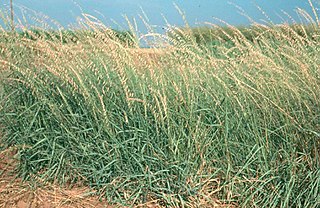
George Bentham was an English botanist, described by the weed botanist Duane Isely as "the premier systematic botanist of the nineteenth century". Born into a distinguished family, he initially studied law, but had a fascination with botany from an early age, which he soon pursued, becoming president of the Linnaean Society in 1861, and a fellow of the Royal Society in 1862. He was the author of a number of important botanical works, particularly flora. He is best known for his taxonomic classification of plants in collaboration with Joseph Dalton Hooker, his Genera Plantarum (1862–1883). He died in London in 1884.

The Mountain Time Zone of North America keeps time by subtracting seven hours from Coordinated Universal Time (UTC) when standard time (UTC−07:00) is in effect, and by subtracting six hours during daylight saving time (UTC−06:00). The clock time in this zone is based on the mean solar time at the 105th meridian west of the Greenwich Observatory. In the United States, the exact specification for the location of time zones and the dividing lines between zones is set forth in the Code of Federal Regulations at 49 CFR 71.

Encelia is a genus of the plant family Asteraceae. It consists of shrubs of arid environments in southwestern North America and western South America.

Bouteloua is a genus of plants in the grass family. Members of the genus are commonly known as grama grass.

HMS Sulphur was a 10-gun Hecla-class bomb vessel of the British Royal Navy, famous as one of the ships in which Edward Belcher explored the Pacific coast of the Americas.

Adenophyllum is a small genus of plants in the tribe Tageteae within the family Asteraceae. It contains ten species known generally as dogweeds.

Perityle is a genus of flowering plants in the daisy family. They are known generally as rock daisies.

Guardiola is a genus of plants in the family Asteraceae, native to Mexico and the southwestern United States. Members of the genus are subshrubs with simple, opposite leaves and terminal inflorescences.

Hofmeisteria is a genus of Mexican flowering plants in the family Asteraceae.

Hilaria is a genus of North American plants in the grass family. Members of the genus are commonly known as curly mesquite. They are found in the Southwestern United States, Mexico, and Guatemala.
Otopappus is a genus of flowering plants in the tribe Heliantheae within the family Asteraceae, primarily Mesoamerican but with one species from Jamaica.
Oxypappus is a genus of flowering plants in the tribe Tageteae within the family Asteraceae.
Parthenice is a genus of flowering plants in the family Asteraceae.

Trichloris is a genus of New World plants in the grass family.

Brickellia hastata is a North American species of shrubs in the family Asteraceae. It is found only in the state of Baja California Sur in western Mexico.
Coreocarpus arizonicus, the little lemonhead, is a North American species of flowering plants in the daisy family native to northwestern Mexico and the southwestern United States. It has been found in southern Arizona, and in the adjacent Mexican States of Sonora, Chihuahua, Sinaloa, and Baja California Sur.
Richard Brinsley Hinds FRCS was a British naval surgeon, botanist and malacologist. He sailed on the 1835–42 voyage by HMS Sulphur to explore the Pacific Ocean, and edited the natural history reports of that expedition.

Tropical Depression Nineteen-E was a weak yet costly tropical cyclone that caused significant flooding throughout Northwestern Mexico and several states within the United States in September 2018. The storm was also the first known tropical cyclone to form over the Gulf of California. Nineteen-E originated from a tropical wave that left the west coast of Africa on August 29 to 30. It continued westward, crossed over Central America, and entered the northeastern Pacific Ocean by September 7. It then meandered to the southwest of Mexico for the next several days as it interacted with a mid-to-upper level trough. The National Hurricane Center (NHC) continued to track the disturbance for the next several days as it traveled northward. A surface trough developed over the Baja California peninsula on September 18. Despite disorganization and having close proximity to land, the disturbance developed into a tropical depression in the Gulf of California on September 19, after having developed a circulation center and more concentrated convection. The system peaked with maximum sustained winds of 35 mph (55 km/h) and a minimum central pressure of 1002 mbar.

Gambelia juncea is a species of flowering shrub in the plantain family commonly known as the Baja California bush snapdragon or Baja bush snapdragon. Gambelia juncea is a highly variable woody perennial to 1 m (3.3 ft) characterized by long, arching, reed-like stems and showy, bright red, two-lipped tubular flowers. Native to the Baja California peninsula and coastal Sonora, this species is widespread in the region across numerous habitats and has several varieties. It was formerly placed in the primarily South American genus Galvezia, but taxonomic studies have supported the reclassification of the two North American species into Gambelia. This species, with a number of cultivars, is widely used as an ornamental shrub for xeriscaping, erosion control, native plant gardens, and wildlife gardens.
Coreocarpus parthenioides is a species of flowering plant in the family Asteraceae. It is found from northwest Mexico. It has 3 varieties: var. parthenioides, var. heterocarpus and var. involutus.













